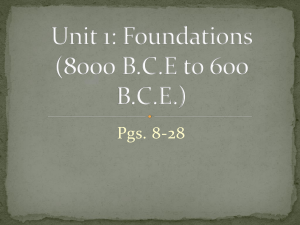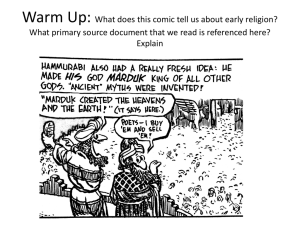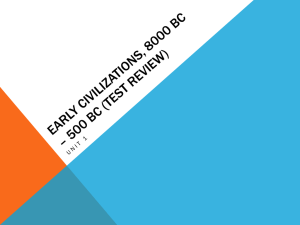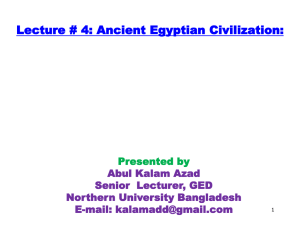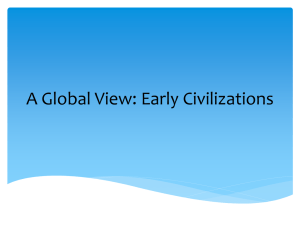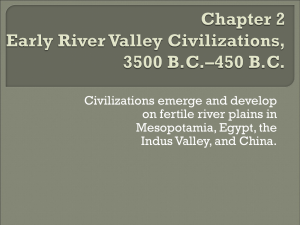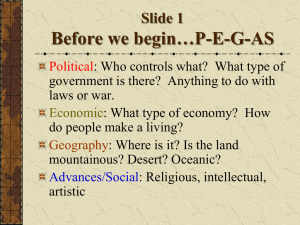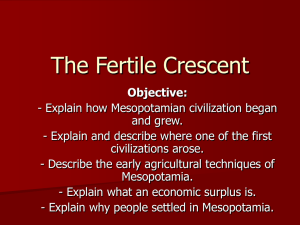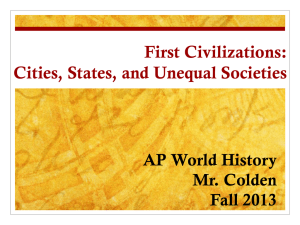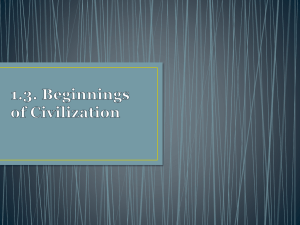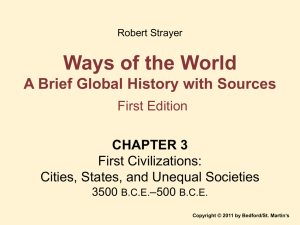Early River Civilizations - Lancaster Central School District
advertisement
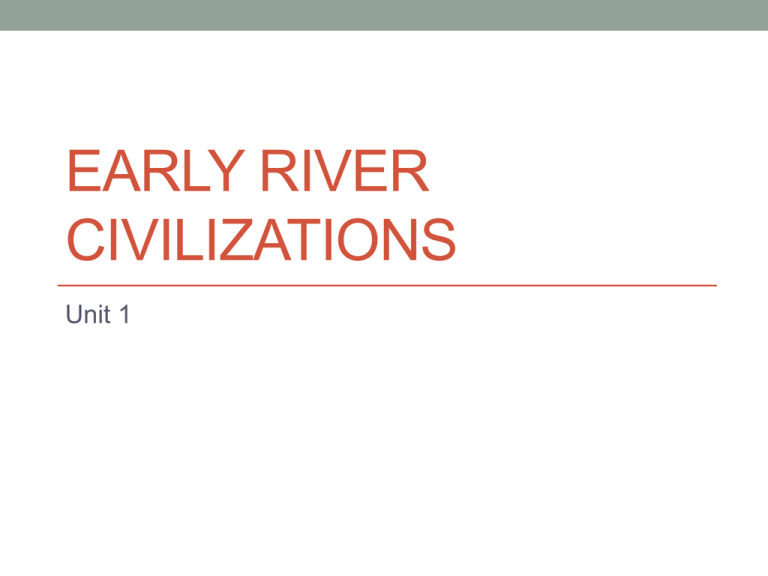
EARLY RIVER CIVILIZATIONS Unit 1 Admit Slip- 9/29 • What do you think of when you hear the word Egypt? Neolithic Revolution • Hunting and gathering were replaced by agriculture and domesticating animals as primary means to obtain food. • Established permanent settlements which resulted in the formation of the world’s first civilizations. • The first civilizations developed along river valleys. • The rich, fertile soil of river valleys helped these civilizations thrive. • Civilization can be defined as a community characterized by elements such as a system of writing, development of social classes, and cities. Ancient Egypt- Where? • Since most of Egypt is a desert, people settled along the • • • • Nile River. The Nile provided water for drinking and for irrigation of crops (farming). Yearly floods soaked the land and left rich deposits of fertile soil called silt. Egyptians settled along the Nile Valley and used the fertile soil to grow a surplus of crops. The Nile River also served as highway for trading goods Nile River Valley Egypt: • The Nile stretches over 4,100 miles, making it the world’s longest river • Every year in July, rains and melting snow from the mountains of east Africa caused the Nile to rise over its banks • When the river receded, it left behind a rich deposit of fertile black mud (silt) • Nile Delta- formed at the mouth of the Nile River Egyptian Religion • Egyptians were polytheistic, with their chief god being • • • • Amon-Re, also known as the sun god. Osiris was the god of the Nile, who controlled the annual floods that would make the land fertile for farming. The Egyptians also believed in a host of other gods who served specific functions. The cornerstone of the Egyptian faith was a belief in life after death. Egyptians prepared their dead for the afterlife through a preservation process known as mummification. Mummification • First, they draw out the brains through the nostrils with an iron hook… Then with a sharp stone they make an incision in the side, and take out all the bowels… Then, having filled the belly with pure myrrh, cassia, and other perfumes, they sew it up again; and when they have done this they steep it in natron [a mineral salt], leaving it for 70 days… At the end of 70 days, they wash the corpse, and wrap the body in bandages of waxen cloth. -Herodotus • 1.) What is the process being described in the passage? • 2.) What connection can you make with this process to modern day? Mummification Website • http://www.ancientegypt.co.uk/mummies/story/main.html Egyptian Government • The Egyptian ruler was called a pharaoh. • Egyptians believed that the pharaoh was both a god and a king. • When pharaohs died, they were buried in pyramids, which took enormous planning and organization to built. • Mummies were buried with prized possessions for use in the afterlife. https://www.youtube.com/watch?v=YgVlXOyU10I Egyptian Society • Egyptian society was divided into classes. • The pharaoh held the highest position in society. Egyptian Contributions • Egyptians made many contributions in both science and • • • • art. The process of mummification helped them learn about the human body, allowing them to diagnose many illnesses and perform surgery. Egyptians developed a calendar, similar to the one we use today. Egyptians developed their own system of picture writing called hieroglyphics. Egyptian temples and monuments, as well as pyramids, survived thousands of years. Exit Slip • What was mummification and why was this a sacred ritual among the Egyptians? • Name one contribution that the Egyptians developed that we use today. • What was the name of the river in Egypt that people lived by? Why did they choose to live there? Admit Slip 9/18 • What do you think the function of this building was? Mesopotamia- “Land Between the Rivers” • Mesopotamia is located northeast of where the Egyptian • • • • • civilization settled. Mesopotamia is located in an area known as the Fertile Crescent. This crescent shaped region of fertile farmland is located in between the Tigris and Euphrates Rivers. Like the Nile, the Tigris and Euphrates Rivers would overflow and enrich the soil with nutrients ideal for farming. The lack of geographic features in the Fertile Crescent allowed frequent invasions. Due to Mesopotamia being open, cultural diffusion took place between many cultures. Mesopotamia -Tigris and Euphrates River provide fertile land for farming (Fertile Crescent) - The rivers flooded once a year providing Mesopotamians with ideal soil called silt - Although the rivers provided fertile soil, the flooding was unpredictable and caused much destruction to both crops and villages Mesopotamian Religion • Sumer • The first civilization in Mesopotamia was called Sumer. • Sumerians were polytheistic, meaning they believed in many gods. • Many of these gods and goddesses were believed to have • • • • human characteristics. Most of the gods were tied to the forces of nature. The largest building in the civilization were pyramid-like temples called ziggurats. Ziggurats had steps that people could climb to reach the shrine of the civilization’s chief god. Ancient Sumerians believed it was their duty to make sure that the gods were happy. Government and Social Structure • Each civilization located in Mesopotamia (city-state) had their own hereditary ruler, who was seen as the chief servant of the gods. • Priests and rulers shared control. • Rulers were expected to collect taxes and enforce laws. Social Class: -Distinct social classes Economy • Since there were little to no geographic barriers surrounding Mesopotamia, Sumer thrived in trading with other civilizations. • Sumerians traded with civilizations as far away as Egypt and India. Contributions • Built the first wheeled vehicles • Had irrigation systems, dikes, and canals to provide protection from floods as well as water for crops • Sumerians invented early form of wedge-shaped writing called cuneiform • Cuneiform was formed by pressing a pen-like instrument into wet clay tablets • Sumerians also developed algebra and geometry https://www.youtube.com/watch?v=Ki8S5I83Ccc Other Civilizations of the Fertile Crescent Assyria • Strong military civilization that conquered all of Fertile Crescent • When the Assyrian empire collapsed, all the people of the Middle East were united by the Persians under Darius. • Darius divided his empire into provinces and built roads. Babylon • Babylon was ruled by a powerful ruler named Hammurabi. • Hammurabi was best known for his set of written laws, known as the Code of Hammurabi. • This was the first major collection of written laws in history. • The punishments were severe, and often favored the upper class. • “Eye for an Eye” Website • http://www.ushistory.org/civ/4c.asp Indus River Valley- Admit Slip • What do you notice about the layout of this particular civilization? • What does this tell you about this particular civilization? • What connections can you make to modern day? Indus River Valley- Geography • Like the civilizations that developed in Egypt and • • • • • Mesopotamia, Indian civilization evolved in a fertile river valley India is a peninsula, meaning it is surrounded by water on three sides, but is connected to a mainland. This peninsula is home to many mountains, which have limited the India’s contact with other cultures. Winds called monsoons bring rain every summer, which would help the Indus River overflow and enrich the surrounding land. When there was not enough rain, people could not grow crops. When there was too much rain, rivers rose and caused deadly floods. Indus River Valley- Geography • Framed by the Indus and Ganges Rivers • Worlds tallest mountains to north (Himalayas) and large desert to east (Thar) helped protect this civilization • Monsoons, however would bring cycles of extremely wet or dry weather making agriculture a daunting task Indus Society • Two main cities of this civilization were Harappa and Mohenjo• • • • • • • Daro. Cities and roads were organized in a grid-like pattern. Cities were built on platforms to combat monsoons Indus Civilizations developed sewage systems to transport waste. Civilization was based on a theocracy,- civilization run by religious leaders. Religion was closely tied to animals and modern Hindu culture Individuals often prayed for good harvests, and moderate monsoons Trade between Afghanistan and Persia Aryan Invasion • By 1750, the Indus River Valley civilizations began to decline. • A group of nomadic warrior called Aryans conquered the area that was once the Indus River Valley. Admit Slip • What were some of the advanced developments we discussed in class about Indus River Valley Civilization? • Which invention do you believe was the most important? Why do you think this? Ancient China • Yellow River and Yangtze River framed the early civilizations of China • The Yellow River would overflow, and create yellow silt along its banks (loess) ideal for farming • The flooding of the Yellow River was also unpredictable, causing it to be called “China’s sorrow” Government and Social Structure • Dynasties, or ruling families ruled over ancient China. • The first dynasty was known as the Shang Dynasty. • Ancient Chinese government was more similar to the • • • • • government in the Indus River Civilization (small kingdoms), rather that the centralized government run by the pharaoh in Egypt. Chinese society had a strict social class structure similar to the other civilizations we have studied thus far. Wealth was determined by how much land you had. A class of noble warriors owned the land. Merchants and craftspeople earned a living in the middle class. Most people were peasants and lived in small farming villages. Religion • The Shang people prayed to many gods and nature spirits • • • • (polytheistic). The Chinese looked to their dead ancestors to communicate with the gods. It was thought that the ancestors would convince the gods to help the living by offering sacrifices of food and other objects. Chinese also believed that the universe was held in delicate balance between two forces, the yin and the yang. When these two forces were in balance, peace and prosperity would result. Chinese Contributions • One of the most important achievements in China was the written language. • The ancient Chinese used a system of writing that included both pictographs (drawings of objects) and ideographs (drawings of thoughts and ideas).Because the Chinese writing system consisted of tens of thousands of characters, only the upper classes had the time to learn to read and write. Oracle Bones used to predict the future Admit Slip • What is a geographic feature? • What are the geographic features discussed in class relating to the river civilizations we studied? • How can geographic features determine where people live? Admit Slip • Take 5 minutes to review your geographic locations from yesterday. • Be ready to defend your opinion on what location you would live in if you were choosing to start your own civilization. • What would you rather prefer?........protection or steady food supply?
